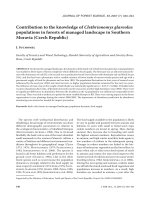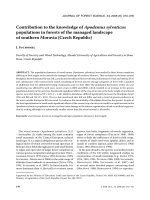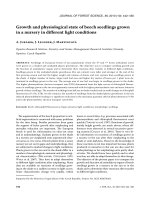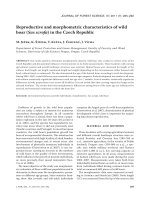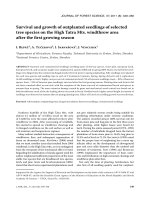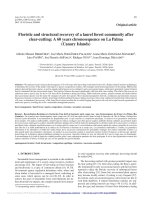Báo cáo lâm nghiệp: "Growth and physiological state of beech seedlings grown in a nursery in different light conditions" docx
Bạn đang xem bản rút gọn của tài liệu. Xem và tải ngay bản đầy đủ của tài liệu tại đây (435.21 KB, 9 trang )
442 J. FOR. SCI., 56, 2010 (10): 442–450
JOURNAL OF FOREST SCIENCE, 56, 2010 (10): 442–450
Supported by the Ministry of Agriculture of the Czech Republic, Project No. MZE 002070203.
Growth and physiological state of beech seedlings grown
in a nursery in diff erent light conditions
A. J, J. L, J. M
Opočno Research Station, Forestry and Game Management Research Institute Strnady,
Opočno, Czech Republic
ABSTRACT: Seedlings of European beech of two populations (from the 4
th
and 7
th
forest altitudinal zone)
were grown in a shaded and unshaded plastic greenhouse. The objective was to compare seedling growth and
the function of assimilatory organs and to determine their reactions after transfer to different light conditions.
Seedlings grown in the unshaded plastic greenhouse (the sun variant) were taller and stronger at the end of the
first growing season and had the higher weight and volume of shoots and root systems than seedlings grown in
the shade. A higher number of leaves, larger total leaf area and higher dry matter of leaves per 1 plant were de-
termined in seedlings grown in the sun. The average area of one leaf was larger in seedlings grown in the shade.
The higher photosynthetic electron transport rate (ETR) determined from the light curves of chlorophyll fluores-
cence in seedlings grown in the sun was apparently connected with the higher photosynthetic rate and more intensive
growth of these seedlings. The transfer of seedlings from full sun to shade resulted only in small changes in chlorophyll
fluorescence (Fv/Fm, ETR). On the contrary, the transfer of seedlings from the shaded plastic greenhouse to the sun
induced photoinhibition leading to a significant reduction in the maximum quantum yield of photochemistry Fv/Fm
and in the photosynthetic electron transport rate (ETR).
Keywords: beech; chlorophyll fluorescence; Fagus sylvatica; light conditions; morphology; seedlings
e augmentation of the beech proportion in arti-
fi cial regeneration is connected with many problems
for the time being. Besides protection from game
the support of faster growth after outplanting and
mortality reduction are important. e European
beech is used for reforestation on clear-cut areas
and in underplantings. If plants grown in the shade
in a nursery are outplanted onto unprotected clear-
cut areas or, vice versa, if beech plants from a sunny
nursery are set out in gaps and underplantings, they
are subjected to marked changes in light conditions.
Plants grown in the sun and in the shade diff er in a
number of morphological, anatomic and physiologi-
cal characteristics (W, O 1997;
W et al. 2007). ey have to adapt themselves
to diff erent light conditions after outplanting. Many
data are available on reactions of seedlings grow-
ing in the shade to a sudden increase in light access.
Some characteristics change very rapidly, within
hours or several days. E.g. processes associated with
photosynthesis and chlorophyll fl uorescence react
quickly (T et al. 1997). Reactions of growth,
mainly height growth, are much slower, where dif-
ferences were observed in several successive grow-
ing seasons (C et al. 2001). ere is very lit-
tle information on reactions of seedlings grown in
a nursery in the sun after their outplanting to the
shade or semi-darkness. However, the knowledge of
these reactions is not less important because plants
produced in nurseries in the sun are also used for
underplantings or for outplantings onto partly shad-
ed sites. We should know how quickly and in what
way they are able to adapt themselves to this change.
e objective of the present paper is to compare the
growth and function of assimilatory organs of beech
seedlings grown in a nursery in the sun or in the
shade and to determine their reactions after transfer
to diff erent light conditions.
J. FOR. SCI., 56, 2010 (10): 442–450 443
MATERIAL AND METHODS
Beechnuts originating from the 4
th
forest alti-
tudinal zone (FAZ) (seed lot CZ-1-2C-BK-20008-
21-4-L) and from the 7
th
FAZ (seed lot CZ-2-2B-
BK-03012-3-7-K) were used for the sowing of
European beech (Fagus sylvatica L.). Germinated
beechnuts were sown into HIKO V-265 trays of
the cell capacity 265 ml of peat substrate enriched
with 1 kg of Multicote slow-release fertilizer (with
6-month solubility at 20°C) per m
3
of substrate.
Seedlings were grown in a plastic greenhouse at
Opočno Research Station of the Research Institute
of Forest and Game Management. A half of the
plastic greenhouse was shaded in such a way that
ca 25% of full sunlight was let through. Seedlings
grown in the unshaded part are designated below
in the text as the “sun” variant; seedlings from the
shaded part are the “shadow” variant. To determine
the reaction to a change in light conditions, in mid-
September a part of trays from the unshaded plas-
tic greenhouse was transferred to the shade and
vice versa. e reaction of assimilatory organs was
evaluated in them within two weeks by measuring
chlorophyll fl uorescence.
Evaluation of morphological characteristics
Detailed evaluation of morphological parameters
in one-year planting material prepared for out-
planting onto research plots was done in the ac-
credited laboratory Nursery Control according to
Standard Methods. In partial samples assimilatory
organs (number of leaves, their area and dry mat-
ter) were evaluated in detail in relation to the other
parts of seedlings.
Measurement of chlorophyll fl uorescence
e method of chlorophyll fl uorescence mea-
surement is used most frequently to study reac-
tions to illumination in dark-adapted leaves. Before
measurement leaves are left in darkness for 20 min
at least. It is ensured that all chlorophyll is in the
steady state and electron transmission pathways
are empty before a light impulse is intercepted. In
this stage fl uorescence has the minimum (basic)
value (Fo). After strong saturation illumination all
acceptors and reaction centres of the photosystem
are fi lled with electrons very quickly (100–200 ms)
and fl uorescence increases to the maximum value
(Fm). e activation of photochemical processes
follows (3–5 s). Electron energy is gradually con-
ducted and stored to highly energetic bonds and
subsequently used for CO
2
assimilation (L-
et al. 2005).
e Fv/Fm ratio is the most important diagnostic
element when Fv is so called variable fl uorescence
calculated as the diff erence between Fm and Fo.
e maximum quantum yield of the photochemis-
try of photosystem 2 (PSII), which is a designation
of the Fv/Fm ratio, provides the exact estimation of
PSII effi ciency. e parameter Fv/Fm is the most
frequently cited result of chlorophyll fl uorescence
measurement (R, L 2005).
Chlorophyll fl uorescence was measured with an
Imaging-PAM 2000 instrument (Walz, Eff eltrich,
Germany) on samples of beech leaves adapted to
darkness for 20 min at least in a humid dark environ-
ment. e light intensity of 3mol·m
–2
·s
–1
and satu-
ration impulse of the intensity 2,400 mol·m
–2
·s
–1
for
800 ms were applied for measurements.
e determination of leaf reaction to increasing
radiation intensity (the light curve) was another
used method. e intensity of photosynthetically
active radiation (PAR) was increased from 0 to
1,414 mol·m
–2
·s
–1
while the interval between the
impulses of saturation light was 10 s. e evaluated
parameter was the photosynthetic electron trans-
port rate (ETR) indicating the velocity of electron
conduction from photosystem 2 (PSII) and their
utilization for further processes of photosynthesis.
is parameter is used especially because its curves
have a similar course like the curves of photosyn-
thetic fi xation of CO
2
(M, J 2000).
Statistical evaluation
e results were processed in Excel programme.
Statistical signifi cance of the diff erences in char-
acteristics between the two variants was deter-
mined by t-test. e confi dence interval with 5%
confi dence level is used to represent variability in
graphs.
RESULTS AND DISCUSSION
Morphological traits of one-year-old seedlings
e basic morphological traits of one-year-old
container seedlings of European beech coming
from seed from the 4
th
FAZ and grown for the
whole growing season in an unshaded or shaded
plastic greenhouse are shown in Table 1 while Ta-
ble 2 shows data on seedlings originating from the
7
th
FAZ.
Seedlings grown in the unshaded plastic green-
house (the sun variant) were taller and stronger;
they had a larger volume of shoots and root sys-
tems compared to seedlings from the shaded plas-
444 J. FOR. SCI., 56, 2010 (10): 442–450
tic greenhouse. e diff erences were highly sta-
tistically signifi cant. e diff erences in the root to
shoot ratio were not unambiguous.
e above-described trend corresponds to ob-
servations of other authors. D and T-
(2005) reported a decrease in the fi nal size of
one-year beech seedlings when shading reducing
the daily light intensity to 40% was used. Faster
growth at increasing light availability under shel-
terwood from 1% to 50% of full light was observed
by B and M (1998) in Fagus gran-
difolia. J et al. (1997) produced contain-
er beech seedlings in the open area, in a gap and
under shelterwood. Seedlings from the open area
were taller than those from the other variants. A
marked decrease in height, diameter, dry matter of
stems, branches, leaves and roots with decreasing
light quantity were also reported by A (2003)
or B (2003). A strong negative infl uence of
the shelterwood density on diameter growth and a
much smaller infl uence on height growth were de-
scribed by C and C (2006).
B and H (1964) observed a reduc-
tion in shoot growth only when the light intensity
was lower than 12%. However, the root weight was
reduced by shading strongly and progressively. On
the contrary, C et al. (2005) stated that unlike
the other morphological traits only a small infl uence
of light conditions was exerted on the shoot to root
ratio and on biomass distribution. Our experiments
provided similar fi ndings. e reaction of growth
and root to shoot ratio to the light intensity may be
Table 1. e comparison of morphological traits of one-year seedlings of European beech originating from the
4
th
FAZ grown in an unshaded (sun) and shaded (shade) plastic greenhouse (the number of evaluated plants in each
variant N = 100)
Variant
Sun Shade
t-value Signifi cance
mean SD mean SD
Height (cm) 29.80 6.724 23.50 4.061 0.005 –
Root length (cm) 16.20 1.089 15.60 1.209 3.872 **
Collar diameter (mm) 5.10 0.940 3.73 0.780 11.257 **
Shoot volume (ml) 4.00 1.428 2.40 0.929 9.159 **
Volume of thick roots (ml) 3.70 1.504 2.10 0.911 8.786 **
Volume of fi ne roots (ml) 1.10 0.593 0.70 0.365 6.550 **
Root/shoot ratio 1.20 0.371 1.10 0.277 1.707 –
Proportion of fi ne root volume (%) 22.60 7.643 22.70 5.968 –0.181 –
SD
– standard deviation, – signifi cance level α = 0.05, **signifi cance level α = 0.01
Table 2. e comparison of morphological traits of one-year seedlings of European beech originating from the
7
th
FAZ grown in an unshaded (sun) and shaded (shade) plastic greenhouse (N = 43 in the sun, N = 32 in the shade)
Variant
Sun Shade
t-value Signifi cance
mean SD mean SD
Height (cm) 33.90 8.343 23.10 4.804 6.513 **
Root length (cm) 16.00 1.068 15.70 1.023 1.338 –
Collar diameter (mm) 4.79 0.710 4.13 0.690 4.069 **
Shoot volume (ml) 5.60 2.685 3.00 1.099 5.230 **
Volume of thick roots (ml) 3.30 1.020 2.50 0.954 3.244 **
Volume of thin roots (ml) 1.00 0.617 0.70 0.338 2.695 **
Root/shoot ratio 0.90 0.296 1.10 0.233 –3.739 **
Proportion of fi ne root volume (%)
23.20 8.943 22.80 7.368 0.183 –
SD – standard deviation, – signifi cance level α = 0.05, **signifi cance level α = 0.01
J. FOR. SCI., 56, 2010 (10): 442–450 445
markedly infl uenced by other environmental fac-
tors, e.g. by water availability (M 1994).
Detailed analysis of assimilatory organs was done
on samples of seedlings from the shaded and un-
shaded plastic greenhouse (21 samples of either
type) (Table 3).
Seedlings grown in the sun were larger and had
more branches and leaves. eir total leaf area and
dry matter of all leaves per 1 seedling were higher.
But average leaf area and average dry weight of one
leaf were higher in seedlings grown in the shade.
Signifi cantly lower dry matter of leaves per plant
and leaf area weight in the shade were described by
Špulák (2008) in beeches from natural regeneration
in the Jizerské hory Mts. Leaf area was much smaller
in these conditions. L and B (1995) re-
ported an increase in leaf area and a decrease in the
number of buds and leaves when the light quantity
was diminished; B (2003) observed a higher
number of assimilatory organs in seedlings grown in
the sun.
Chlorophyll fl uorescence in beech seedlings
growing in diff erent light conditions
e state and function of assimilatory organs
were evaluated by measuring chlorophyll fl uores-
cence (Fig. 1). e comparison of chlorophyll fl uo-
rescence of seedlings grown in the unshaded and
shaded plastic greenhouse showed higher values
of the maximum quantum yield of photochemistry
Fv/Fm in beeches grown in the shade. is trend
was evident for the whole period of observation
(from June to October), in seedlings from both the
4
th
and 7
th
FAZ. But the diff erences were small and
usually statistically insignifi cant.
Table 3. e comparison of morphological traits of one-year seedlings of European beech grown in an unshaded (sun)
and shaded (shade) plastic greenhouse (N = 21)
Variant Sun Shade
Signifi cance
Morphological trait mean SD mean SD
Shoot height (cm) 28.1 4.259 24.1 3.458 **
Number of branches per 1 seedling 1.4 1.137 0.7 1.084 *
Number of leaves per 1 seedling 14.9 6.018 8.7 3.399 **
Leaf area per 1 seedling (cm
2
) 198.6 63.670 160.2 35.214 *
Average area of 1 leaf (cm
2
) 14.1 3.104 19.6 4.096 **
Leaf dry matter per 1 seedling (g) 0.98 0.322 0.65 0.156 **
Average leaf area weight (g·cm
–2
) 0.0049 0.0009 0.0041 0.0005 **
Average dry matter of 1 leaf (g) 0.0697 0.0207 0.0806 0.0200 –
Ratio of leaf area to seedling height 7.2 2.877 6.7 1.304 –
SD – Standard deviation, – signifi cance indiff erent, *signifi cance level α = 0.05, **signifi cance level α = 0.01
0.70
0.74
0.78
0.82
0.86
sun
shadow
0.70
0.74
0.78
0.82
0.86
20. 6. 25. 9. 3. 10. 20. 6. 25. 9. 3. 10.
sun
shadow
4
th
FAZ
7
th
FAZ
Fig. 1. e maximum quantum yield of photosystem 2 (PSII) Fv/Fm of European beech seedlings originating from the
4
th
and 7
th
FAZ grown in an unshaded (sun) and shaded (shade) plastic greenhouse. Vertical line segments represent
the confi dence on 5% of signinifi cance
446 J. FOR. SCI., 56, 2010 (10): 442–450
E et al. (2004), who measured the lowest
values of Fv/Fm in beech seedlings growing in the
open area, higher values in the gap and the highest
values in seedlings growing under shelterwood, ex-
plained these diff erences by increased photoinhibi-
tion in beeches in the gap and in the open area. But
the higher photoinhibition did not have a negative
infl uence on total biomass accumulation. ey stat-
ed that such photoinhibition was of adaptive charac-
ter and did not damage the assimilatory organs.
Higher values of the maximum quantum yield of
PSII (Fv/Fm) photochemistry in beech seedlings in
the shade compared to seedlings on the area with
higher light access were reported by Š (2008).
Signifi cantly higher values in shaded beech plants
compared to plants growing in direct sun were also
measured by V et al. (2002). ey con-
cluded that these were species-specifi c diff erences
as they did not observe this trend in oak.
In beech seedlings from both the 4
th
and the
7
th
FAZ the evaluation of the reaction of assimila-
tory organs to increasing light intensity revealed
statistically signifi cant diff erences in the photosyn-
thetic electron transport rate (ETR) between the
sun and shade variant in the plastic greenhouse.
Seedlings exposed to full sunlight had the markedly
higher ETR especially at lower and medium values
of photosynthetically active radiation (PAR) and
higher maximum values of ETR. A similar course
of ETR curves and diff erences between plants
grown in the sun and in the shade were observed in
seedlings from both the 4
th
and the 7
th
FAZ during
the whole growing season (Fig. 2).
Higher maximum values of ETR in unshaded
seedlings of various tree species including the Euro-
pean beech compared to heavily shaded plants were
described by W et al. (2007). S (1997)
reported that shady leaves showed the saturation of
ETR at lower values of PAR than did sunny leaves
and they were characterized by the lower ETR.
ese results support the fi ndings of the higher pho-
tosynthetic rate of beech plants growing in high light
compared to shaded plants (T et al. 1997).
Reaction of assimilatory organs to changes in
light conditions
To determine the reaction of seedlings grown in
a plastic greenhouse to a sudden change in light
conditions (e.g. after outplanting) a part of trays
(56 plants) with seedlings from sunny conditions
was transferred to the shade in mid-September,
and vice versa, the same number of plants from
the shade was transferred to an unshaded plastic
greenhouse. Chlorophyll fl uorescence was repeat-
edly measured during two subsequent weeks.
A slight increase in the values of the maximum
quantum yield of fl uorescence Fv/Fm was observed
10
20
30
40
50
60
T
R (μmol·m
–2
·s
–1
)
20. 6. 2007 – 4
th
FAZ
sun
shado
w
0
10
20
30
40
50
60
0 200 400 600 800 1,000 1,200
ETR (μmol·m
–2
·s
–1
)
PAR (μmol·m
–2
·s
–1
)
20. 6. 2007 – 4
th
FAZ
sun
shado
w
20. 6. 2007 – 7
th
FAZ
50
60
1
)
20. 6. 2007 – 7
th
FAZ
30
40
50
60
o
l·m
–2
·s
–1
)
20. 6. 2007 – 7
th
FAZ
10
20
30
40
50
60
ETR (μmol·m
–2
·s
–1
)
20. 6. 2007 – 7
th
FAZ
sun
shadow
0
10
20
30
40
50
60
ETR (μmol·m
–2
·s
–1
)
20. 6. 2007 – 7
th
FAZ
sun
shadow
0
10
20
30
40
50
60
0 200 400 600 800 1,000 1,200
ETR (μmol·m
–2
·s
–1
)
PAR (μmol·m
–2
·s
–1
)
20. 6. 2007 – 7
th
FAZ
sun
shadow
0
10
20
30
40
50
60
0 200 400 600 800 1,000 1,200
ETR (μmol·m
–2
·s
–1
)
PAR (μmol·m
–2
·s
–1
)
20. 6. 2007 – 7
th
FAZ
sun
shadow
Fig. 2. e photosynthetic electron transport rate (ETR) at the increasing intensity of photosynthetically active ra-
diation (PAR) in beech seedlings from the 4
th
and 7
th
FAZ grown in an unshaded (sun) and shaded (shade) plastic
greenhouse. Vertical line segments represent the confi dence on 5% of signinifi cance
60
3. 10. 2007 – 4
th
FAZ
50
60
1
)
3. 10. 2007 – 4
th
FAZ
30
40
50
60
o
l·m
–2
·s
–1
)
3. 10. 2007 – 4
th
FAZ
10
20
30
40
50
60
E
TR (μmol·m
–2
·s
–1
)
3. 10. 2007 – 4
th
FAZ
sun
shado
w
0
10
20
30
40
50
60
ETR (μmol·m
–2
·s
–1
)
3. 10. 2007 – 4
th
FAZ
sun
shadow
0
10
20
30
40
50
60
0 200 400 600 800 1,000 1,200
ETR (μmol·m
–2
·s
–1
)
PAR (μmol·m
–2
·s
–1
)
3. 10. 2007 – 4
th
FAZ
sun
shadow
0
10
20
30
40
50
60
0 200 400 600 800 1,000 1,200
ETR (μmol·m
–2
·s
–1
)
PAR (μmol·m
–2
·s
–1
)
3. 10. 2007 – 4
th
FAZ
sun
shadow
60
3. 10. 2007 – 7
th
FAZ
50
60
1
)
3. 10. 2007 – 7
th
FAZ
30
40
50
60
o
l·m
–2
·s
–1
)
3. 10. 2007 – 7
th
FAZ
10
20
30
40
50
60
E
TR (μmol·m
–2
·s
–1
)
3. 10. 2007 – 7
th
FAZ
sun
shado
w
0
10
20
30
40
50
60
ETR (μmol·m
–2
·s
–1
)
3. 10. 2007 – 7
th
FAZ
sun
shadow
0
10
20
30
40
50
60
0 200 400 600 800 1,000 1,200
ETR (μmol·m
–2
·s
–1
)
PAR (
μ
mol·m
–2
·s
–1
)
3. 10. 2007 – 7
th
FAZ
sun
shadow
0
10
20
30
40
50
60
0 200 400 600 800 1,000 1,200
ETR (μmol·m
–2
·s
–1
)
PAR (
μ
mol·m
–2
·s
–1
)
3. 10. 2007 – 7
th
FAZ
sun
shadow
J. FOR. SCI., 56, 2010 (10): 442–450 447
after transfer from the sun to the shade that per-
sisted until the last evaluation at the beginning of
October (Fig. 3).
On the contrary, after seedlings grown in the
shade were transferred to the unshaded plastic
greenhouse, there occurred high photoinhibition
that caused a decrease in the Fv/Fm values. With-
in two weeks after the transfer of beech seedlings
from the shade to the sun the values of the maxi-
mum quantum yield of fl uorescence Fv/Fm were
slightly increasing and signifi cant diff erences from
the other variants were observed until the begin-
ning of October (the last measurement). e de-
scribed trend was found out in seedlings from both
the 4
th
and 7
th
FAZ.
A similar reaction of shade-adapted beech plants
after transfer to high light was described by W
et al. (2007). e rate and duration of photoinhi-
bition (measured as a decrease in the maximum
quantum yield Fv/Fm) were species specifi c; they
were highest in beech, much lower in spruce and
fi r and the lowest in maple. Higher values of Fv/Fm
in beech seedlings growing at a low radiation in-
tensity compared to seedlings growing at a high
light intensity in the growth chamber were ob-
served by T et al. (1997). After a change in
light conditions from low to high radiation inten-
sity there was a signifi cant decrease in the Fv/Fm
values. Within another three weeks following the
change in light conditions these values continued
to decrease.
A decrease in the Fv/Fm values of seedlings grow-
ing in the shade that occurred immediately after
transfer to a gap was also reported by N and
DL (1997) in oak and maple. e decrease
was followed by a slow return to the initial values.
e maximum quantum yield of Fv/Fm of leaves
growing in the shade after transfer to a gap was still
lower after 30 days than in the leaves of plants left
in the shade and in control seedlings growing in the
gap.
Photoinhibition in beech seedlings grown in
the shade and transferred to full light caused a re-
duction in the photosynthetic electron transport
rate (ETR) measured during the increasing inten-
sity of photosynthetically active radiation (PAR).
Fig. 4 illustrates the maximum values of ETR ob-
tained from light curves at PAR increasing from 0
to 1,414mol·m
–2
·s
–1
. Seedlings grown in the sun
(variant s) reached signifi cantly higher values of
ETR compared to seedlings from the shaded plastic
greenhouse (variant t). e reactions of seedlings
from various environments to transfer to diff erent
light conditions were diff erent. While the seedlings
grown in the unshaded plastic greenhouse (sun)
did not show any greater changes in ETR after
their transfer to the shade (variant s–t), there was
a marked reduction in the photosynthetic electron
transport rate in the seedlings grown in the shade
after their transfer to the sun (variant t–s). e re-
sults were similar in seedlings from both the 4
th
and
7
th
FAZ.
4
th
FAZ
0.85
0.90
4
th
FAZ
s
s–t
075
0.80
0.85
0.90
4
th
FAZ
s
s–t
t
t–s
0.65
0.70
0.75
0.80
0.85
0.90
4
th
FAZ
s
s–t
t
t–s
0.60
0.65
0.70
0.75
0.80
0.85
0.90
0
5
10
15
20
25
4
th
FAZ
s
s–t
t
t–s
0.60
0.65
0.70
0.75
0.80
0.85
0.90
0 5 10 15 20 25
Days after transfer
4
th
FAZ
s
s–t
t
t–s
0.60
0.65
0.70
0.75
0.80
0.85
0.90
0 5 10 15 20 25
Days after transfer
4
th
FAZ
s
s–t
t
t–s
065
0.70
0.75
0.80
0.85
0.90
7
th
FAZ
s
s–t
t
t–s
0.60
0.65
0.70
0.75
0.80
0.85
0.90
0 5 10 15 20 25
Days after transfer
7
th
FAZ
s
s–t
t
t–s
Fig. 3. Changes in chlorophyll
fluorescence Fv/Fm after the
transfer of beech seedlings from
shade to sun and vice versa com-
pared to seedlings left in the
initial light conditions (s = seed-
lings in the sun, s–t = transport
from sun to shade, t = left in
the shade, t–s = transport from
shade to sun)
448 J. FOR. SCI., 56, 2010 (10): 442–450
e evaluation of chlorophyll fl uorescence of Eu-
ropean beech seedlings grown under diff erent light
conditions showed signifi cantly higher values of
the photosynthetic electron transport rate (ETR)
in seedlings grown in the unshaded plastic green-
house. From such values the higher photosynthetic
rate can be deduced in these seedlings. It also im-
plies more intensive growth and larger size of seed-
lings grown in the sun compared to seedlings in the
shade.
e evaluation of chlorophyll fl uorescence af-
ter beech seedlings were transferred to diff erent
light conditions demonstrated the relatively small
reaction of seedlings transferred from the sun to
the shade. Only small changes in the evaluated pa-
rameters of chlorophyll fl uorescence (Fv/Fm, ETR
curves) were observed. On the contrary, the trans-
fer of shade-adapted seedlings to the sun led to a
marked decrease both in the maximum yield of pho-
tochemistry Fv/Fm and in the photosynthetic elec-
tron transport rate (ETR). ese results document
the high photoinhibition of assimilatory organs.
e full acclimatization of beech seedlings is a
gradual process observable during several subse-
quent growing seasons (R and F
2003). Further evaluation of the survival and growth
of seedlings grown in the sun and in the shade after
their outplanting to diff erent conditions will show
to what extent the need of adaptation to diff erent
light conditions will infl uence their performance.
e measurement of ETR is used mainly for its
close relationship with the CO
2
assimilation rate.
Under certain conditions the electron fl ow through
PSII is an indicator of the total photosynthetic
rate (M, J 2000). T et
al. (1997) studied the photosynthetic rate in beech
seedlings grown in a growth chamber at low and
high light intensity. ey also investigated the re-
action of seedlings adapted to low light intensity
after their exposure to high radiation intensity. e
photosynthetic rate was highest in seedlings per-
manently grown at high light intensity. After the
light intensity changed (from low to high intensi-
ty), a steady reduction in the photosynthetic rate
was observed within several weeks. e authors
ascribed these changes to photoinhibition that oc-
curred after the leaves were exposed to light condi-
tions exceeding the intensity that may be used for
photosynthesis. Photoinhibition is also indicated
by a marked decrease in the values of chlorophyll
fl uorescence Fv/Fm following the change in light
conditions.
During photoinhibition the photosynthetic ca-
pacity is reduced on the level of the light phase of
photosynthesis, i.e. in processes of the capture and
transmission of radiant energy quanta. e long-
term eff ect of excessive PAR leads to the photode-
struction of assimilatory organs when the bleach-
ing of photosynthetic pigments occurs (Š,
M 1996).
20
40
60
80
4
th
FAZ
0
20
40
60
80
s
14. 9.
tss–t
17. 9.
tt–sss–t
25. 9.
tt–sss–t
3. 10.
tt–s
4
th
FAZ
80
7
th
FAZ
60
80
7
th
FAZ
20
40
60
80
7
th
FAZ
0
20
40
60
80
7
th
FAZ
0
20
40
60
80
s
14. 9.
tss–t
17. 9.
t
t
–s s s–t
25. 9.
t
t
–s s s–t
3. 10.
t
t
–s
7
th
FAZ
0
20
40
60
80
s
14. 9.
tss–t
17. 9.
t
t
–s s s–t
25. 9.
t
t
–s s s–t
3. 10.
t
t
–s
7
th
FAZ
0
20
40
60
80
s
14. 9.
tss–t
17. 9.
t
t
–s s s–t
25. 9.
t
t
–s s s–t
3. 10.
t
t
–s
7
th
FAZ
Fig. 4. Maximum values of photosynthetic
electron transport rate (ETR) obtained
from light curves in beech seedlings grown
in the sun and in the shade within 2 weeks
after a change in light conditions (descrip-
tion of the variants see Fig. 3). Vertical line
segments represent the confi dence on 5%
of signinifi cance
J. FOR. SCI., 56, 2010 (10): 442–450 449
CONCLUSION
European beech seedlings grown in an unshaded
plastic greenhouse were larger at the end of the fi rst
growing season than seedlings grown in the shaded
part. ey had taller shoots, larger root collar di-
ameters and higher weight and volume of shoots
and root systems. In seedlings grown in the sun a
higher number of leaves, larger total leaf area and
higher dry matter of leaves per 1 plant were deter-
mined. e average area of one leaf was larger in
seedlings grown in the shade.
Diff erent light conditions during growing did not
usually infl uence the root to shoot ratio, the pro-
portion of fi ne roots in the root system and the ra-
tio of leaf area to seedling height.
e measurement of chlorophyll fl uorescence
showed lower values of the maximum quantum
yield of photosystem PSII (Fv/Fm) in seedlings
grown in the sun that indicate partial photoinhibi-
tion. e higher photosynthetic electron transport
rate (ETR) evaluated at the increasing intensity of
photosynthetically active radiation (PAR) in seed-
lings grown in the sun was apparently connected
with the higher photosynthetic rate and more in-
tensive growth of these seedlings.
e transfer of seedlings from full sun to shade
resulted only in small changes in chlorophyll fl uo-
rescence (Fv/Fm, ETR). On the contrary, the trans-
fer of seedlings from the shaded plastic greenhouse
to the sun induced photoinhibition leading to a sig-
nifi cant decrease in the maximum quantum yield
of photochemistry Fv/Fm and photosynthetic elec-
tron transport (ETR), which also indicates a reduc-
tion in the photosynthetic rate.
e described results document that the out-
planting of the beech planting material to diff erent
light conditions from those in which it was grown
requires its overall adaptation to the new environ-
ment. How serious the need of such adaptation of
beech seedlings grown in the sun and in the shade
is after their outplanting to diff erent conditions
must be tested in further research.
References
A C. (2003): Growth and biomass partitioning of Fagus
sylvatica L. and Quercus robur L. seedlings in response to
shading and small changes in the R/FR-ratio of radiation.
Annals of Forest Science, 60: 163–171.
B M., M C. (1998): Growth and morphological
responses of yellow birch, sugar maple, and beech seedlings
growing under a natural light gradient. Canadian Journal
of Forest Research, 28: 1007–1015.
B M. (2003): Ontogeny of beech seedlings in the fi rst
vegetation period in stand conditions. Glasnik Šumarskog
Fakulteta, Univerzitet u Beogradu, 86: 81–91.
B P., H J. (1964): e reaction of Beech seedlings
to shade. Forstarchiv, 35: 225–33.
C C., C C. (2006): Using competition and light
estimates to predict diameter and height growth of natu-
rally regenerated beech seedlings growing under changing
canopy conditions. Forestry, 79: 489–502.
C C., L O., P M. (2001): Eff ects of canopy
opening on height and diameter growth in naturally regener-
ated beech seedlings. Annals of Forest Science, 58: 127–134.
C T., C L., P B., B P., K
G. (2005): Plasticity in growth, biomass allocation and root
morphology in beech seedlings as induced by irradiance
and herbaceous competition. Annals of Forest Science,
62: 51–60.
D T., T S. (2005): Production of European
beech Fagus sylvatica L. seedlings in bare-root forest
nurseries of north-eastern Poland. Sylwan, 149: 15–24.
(in Polish)
E K.S., R E., L J.W. (2004):
Photoinhibition in seedlings of Fraxinus and Fagus under
natural light conditions: implications for forest regenera-
tion? Oecologia, 140: 243–251.
J J.D., T R., M M., PS.,
M G., B M. (1997): Ecophysiological
responses of Fagus sylvatica seedlings to changing light
conditions. II. e interaction of light environment and
soil fertility on seedling physiology. Physiologia Plantarum,
101: 124–134
L J.B., B T. (1995): e infl uence of light, lime,
and NPK-fertilizer on leaf morphology and early growth
of diff erent beech provenances (Fagus sylvatica L.). Forest
& Landscape Research, 1: 227–240.
L H.K., B F., L G.,
B C. (2000): Measurement of diff erences in
red chlorophyll fl uorescence and photosynthetic activity
between sun and shade leaves by fl uorescence imaging.
Photosynthetica 38: 521–529.
M P. (1994): Growth and survival of Fagus sylvatica
seedlings in relation to light intensity and soil water con-
tent. Scandinavian Journal of Forest Research, 9: 316–322.
M K., J G.J. (2000): Chlorophyll fl uores-
cence - a practical guide. Journal of Experimental Botany
51(345): 659–668.
N S.L., DL E.H. (1998): Physiological and mor-
phological acclimation of shade-grown tree seedlings to
late-season canopy gap formation. Journal Plant Ecology,
138: 27–40.
R P.E., F H. (2003): Photosynthetic acclima-
tion of beech seedlings to full sunlight following a major
windstorm event in France. Annals of Forest Science, 60
(Special Issue): 701–709.
450 J. FOR. SCI., 56, 2010 (10): 442–450
R G., L T.D. (2005): Seedling quality tests Chlo-
rophyll fl uorescence. Forest Nursery Notes, USDA, Forest
Service, Winter 2005. Portland, USDA Forest Service,
Pacifi c Northwest Region: 12–16.
S U. (1997): Chlorophyll Fluorescence and Pho-
tosynthetic Energy Conversion: Simple Introductory
Experiments with the TEACHING-PAM Chlorophyll Fluo-
rometer. Eff eltrich, Heinz Walz GmbH: 73.
Š M., M M. (1996): High rates of solar radiation
– an important natural stress factor of the photosynthetic
activity of mountainous Norway spruce stands. Lesnictví-
Forestry 42: 271–276.
Š O. (2008): Assimilation apparatus variability of
beech transplants grown in variable light conditions of
blue spruce shelter. Journal of Forest Science, 54: 491–496.
T R., J J.D., M M. (1997):
Ecophysiological responses of Fagus sylvatica seedlings
to changing light conditions. I. Interactions between
photosynthetic acclimation and photoinhibition during
simulated canopy gap formation. Physiologia Plantarum,
101: 115–123.
V F., C J. M., A I., B L.,
D P., M E., D E. (2002): e
greater seedling high-light tolerance of Quercus robur over
Fagus sylvatica is linked to a greater physiological plasticity.
Trees: Structure and Function, 16: 395–403.
W N.T., O B. (1997): Infl uence of photo-
synthetic photon fl ux density on growth and transpira-
tion in seedlings of Fagus sylvatica. Tree Physiology, 17:
133–140.
W T., R P., Ż R. (2007): Acclima-
tion of leaves to contrasting irradiance in juvenile trees dif-
fering in shade tolerance. Tree Physiology, 27: 1293–1306.
Recieved for publication January 18, 2010
Accepted after corrections June 3, 2010
Corresponding author:
Ing. J L, Výzkumný ústav lesního hospodářství a myslivosti, v.v.i., Strnady, Výzkumná stanice Opočno,
Na Olivě 550, 517 73 Opočno, Česká republika
tel.: + 420 494 668 392, fax: + 420 494 668 393, e-mail:
